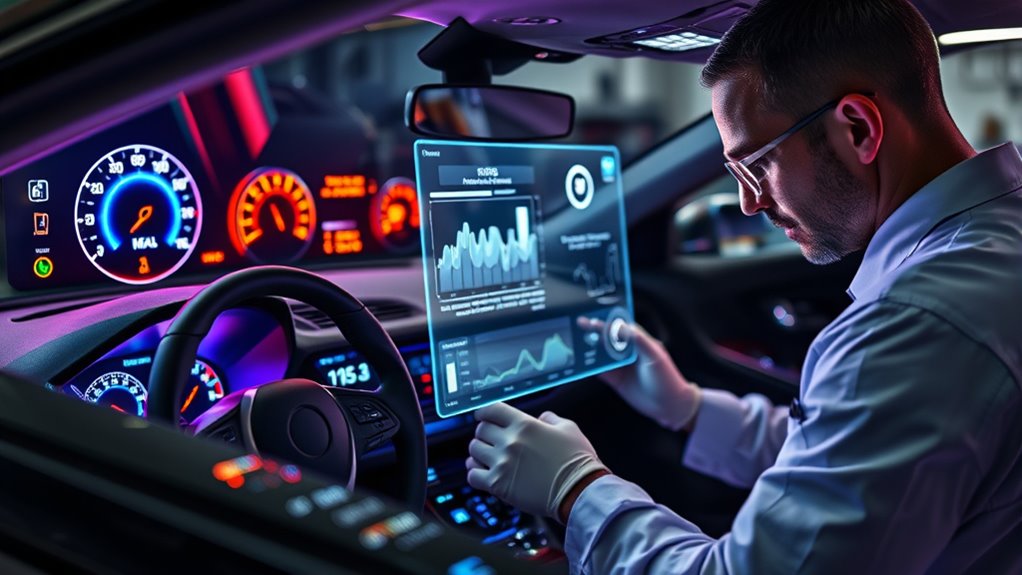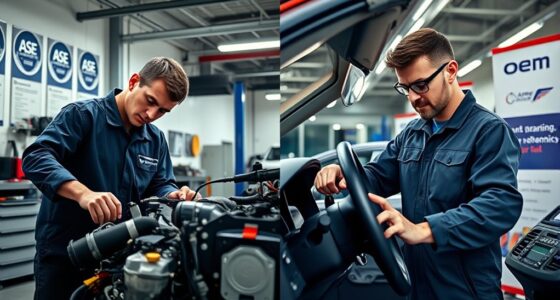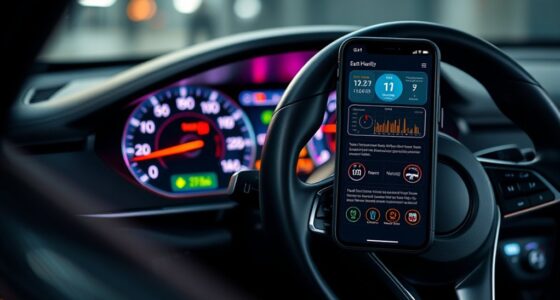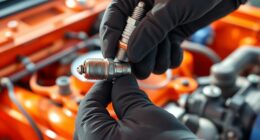Predictive maintenance is changing how you care for your car by using sensors and data analysis to spot issues early. Instead of waiting for breakdowns, you get alerts that help schedule repairs before problems become costly. Precise sensor calibration guarantees accurate readings, and machine learning spots patterns that signal wear or faults. As technology improves, you’ll enjoy smarter, more efficient maintenance—stay with us to discover how this revolution keeps your vehicle in top shape.
Key Takeaways
- Predictive maintenance uses sensors and data analytics to identify issues early, preventing costly breakdowns.
- Calibration of sensors ensures accurate data collection, improving the reliability of maintenance predictions.
- Machine learning analyzes sensor data to detect subtle signs of wear, enabling timely interventions.
- It extends vehicle lifespan and optimizes maintenance scheduling, reducing unexpected failures.
- Advances in technology are making predictive maintenance more accessible, transforming traditional car care into a proactive process.
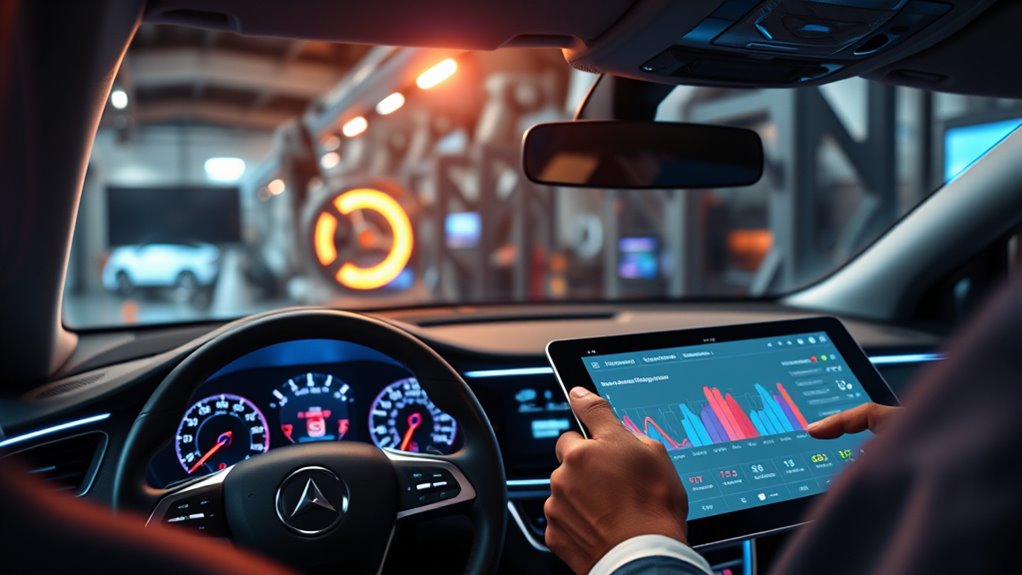
Predictive maintenance is transforming how you care for your car by using data and technology to anticipate issues before they become costly problems. Instead of waiting for a warning light or a breakdown, you’re now able to catch potential problems early, saving you time and money. At the core of this shift are advanced sensors and powerful data analytics that work together to monitor your vehicle’s health in real time. These sensors continually gather information about various components—like the engine, brakes, and suspension—ensuring you have up-to-date insights into their condition. But for these sensors to provide accurate data, proper sensor calibration is vital. Calibration ensures that the sensors’ readings are precise, which directly impacts the quality of the data you receive. When sensors are correctly calibrated, you get trustworthy signals that accurately reflect the true state of your car, reducing false alarms and missed issues. This process involves adjusting the sensors to match known standards or reference points, often requiring specialized tools or software. Once calibrated, these sensors feed their data into sophisticated data analytics platforms, which analyze the information to identify patterns or anomalies that might indicate a developing problem. Data analytics uses algorithms and machine learning models to sift through vast amounts of data, highlighting issues you might not notice otherwise. For example, subtle changes in vibration patterns or temperature readings could signal wear in a critical part, prompting early intervention before a breakdown occurs. This proactive approach means your car can be serviced during scheduled maintenance rather than emergency repairs, and you can plan for repairs when it’s most convenient. Moreover, data analytics can generate predictive insights, estimating when a part might fail so you can replace it beforehand. This not only minimizes the risk of unexpected breakdowns but also extends the lifespan of your vehicle’s components. As your car continuously communicates with these analytics systems, you gain a deeper understanding of its health, helping you make informed decisions about maintenance schedules and driving habits. You might even receive alerts or recommendations directly on your smartphone, making car care more streamlined and less stressful. Additionally, advancements in sensor calibration and data analytics for vehicle health monitoring are making these systems more accurate and accessible to everyday drivers. Overall, integrating sensor calibration and data analytics into your vehicle’s maintenance routine revolutionizes how you maintain your car. It shifts your approach from reactive to proactive, providing peace of mind and optimized performance. With these advancements, you no longer have to rely solely on traditional checks or wait for something to go wrong—your car becomes smarter, more efficient, and better equipped to serve you reliably mile after mile.
Frequently Asked Questions
How Accurate Is Predictive Maintenance in Preventing Car Breakdowns?
Predictive maintenance is quite accurate in preventing car breakdowns, especially when sensor accuracy is high. You benefit from real-time data that helps you schedule maintenance before issues worsen. As long as the sensors reliably detect problems and maintenance scheduling is timely, you’ll see fewer breakdowns. This proactive approach minimizes unexpected repairs, making your car more dependable and extending its lifespan.
What Are the Costs Associated With Implementing Predictive Maintenance?
Implementing predictive maintenance involves some initial implementation costs and technological investments. You’ll need to purchase sensors, onboard diagnostics, and data analytics systems, which can be pricey upfront. However, these costs often pay off by reducing long-term repair expenses and downtime. Keep in mind, ongoing expenses include software updates and system maintenance. Overall, while the upfront investment may seem high, the savings and efficiency gains make it a worthwhile expense for your car care.
How Does Predictive Maintenance Impact Long-Term Vehicle Resale Value?
Predictive maintenance can boost your vehicle’s resale value by keeping it in ideal condition, reducing vehicle depreciation over time. When you maintain your car proactively, potential buyers see a well-cared-for vehicle with fewer repairs needed, increasing its appeal. This proactive approach signals responsible ownership, helping you command higher resale prices and retain more value, making your investment in predictive tech worthwhile long-term.
Can Predictive Maintenance Be Integrated With Existing Car Warranty Plans?
Yes, predictive maintenance can be integrated with existing car warranty plans. You might see warranty providers offering coverage adjustments or add-ons that include predictive diagnostics. This integration allows you to benefit from proactive repairs, reducing unexpected costs. To maximize coverage, check with your warranty provider about warranty integration options and guarantee your maintenance data is shared for accurate coverage decisions. This approach keeps your vehicle protected and minimizes downtime.
What Types of Sensors Are Used in Predictive Maintenance Systems?
Imagine tiny sensors working tirelessly to keep your car in top shape. These sensors include temperature sensors, vibration sensors, pressure sensors, and ultrasonic sensors. They collect crucial data during every trip, monitoring engine health, tire pressure, and fluid levels. By gathering this data, predictive maintenance systems can identify issues early, preventing breakdowns and saving you money. These sensor types are essential for accurate data collection and proactive car care.
Conclusion
Imagine your car as a patient in a high-tech hospital, where sensors act like vigilant doctors catching problems before symptoms appear. With predictive maintenance, you avoid unexpected breakdowns—saving time, money, and stress. Just like a skilled doctor prevents a small illness from turning into a crisis, this technology spots issues early. Embracing predictive maintenance transforms car care into a proactive, worry-free experience, ensuring your vehicle stays healthy and reliable for years to come.
